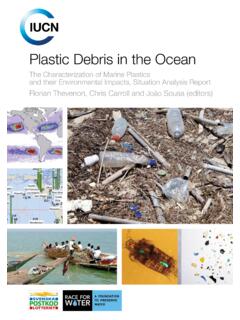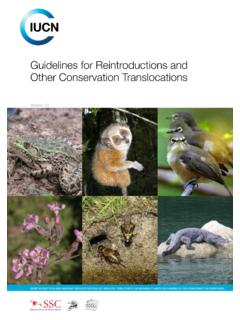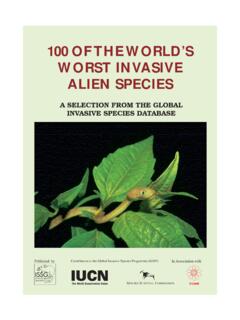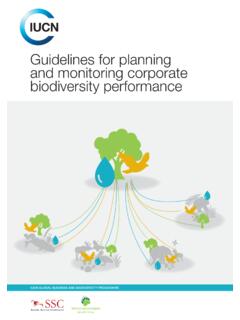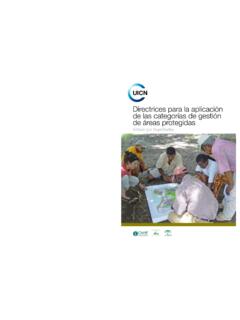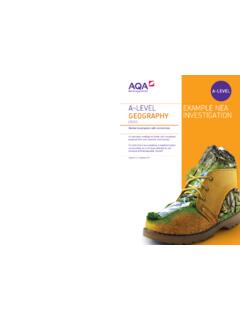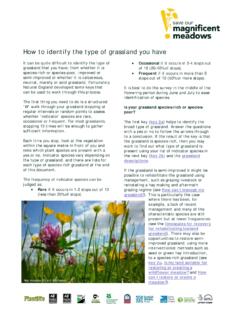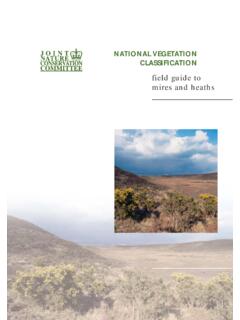Transcription of IUCN Global Ecosystem Typology 2
1 IUCN Global Ecosystem Typology profiles for biomes and Ecosystem functional groupsDavid A. Keith, Jose R. Ferrer-Paris, Emily Nicholson and Richard T. Kingsford (editors) INTERNATIONAL UNION FOR CONSERVATION OF NATURE About IUCNIUCN is a membership Union uniquely composed of both government and civil society organisations. It provides public, private and non-governmental organisations with the knowledge and tools that enable human progress, economic development and nature conservation to take place in 1948, IUCN is now the world s largest and most diverse environmental network, harnessing the knowledge, resources and reach of more than 1,400 Member organisations and some 15,000 experts.
2 It is a leading provider of conservation data, assessments and analysis. Its broad membership enables IUCN to fill the role of incubator and trusted repository of best practices, tools and international provides a neutral space in which diverse stakeholders including governments, NGOs, scientists, businesses, local communities, indigenous peoples organisations and others can work together to forge and implement solutions to environmental challenges and achieve sustainable the Commission on Ecosystem Management (CEM)The Commission on Ecosystem Management (CEM) promotes Ecosystem -based approaches for the management of landscapes and seascapes, provides guidance and support for Ecosystem -based management and promotes resilient socio-ecological systems to address Global Global Ecosystem Typology profiles for biomes and Ecosystem functional groupsDavid A.
3 Keith, Jose R. Ferrer-Paris, Emily Nicholson and Richard T. Kingsford (editors) IUCN, Gland, Switzerland 2020 IUCN, International Union for Conservation of Nature and Natural Resources Reproduction of this publication for educational or other non-commercial purposes is authorized without prior written permission from the copyright holder provided the source is fully of this publication for resale or other commercial purposes is prohibited without prior written permission of the copyright , , Ferrer-Paris, , Nicholson, E. and Kingsford, (eds.) (2020). The IUCN Global Ecosystem Typology : Descriptive profiles for biomes and Ecosystem functional groups.
4 Gland, Switzerland: IUCN. Individual chapters/sections within this report should be cited as: Author(s) (2020). 'Title of chapter/section'. In: Keith, Ferrer-Paris, E. Nicholson and Kingsford (eds.) (2020). The IUCN Global Ecosystem Typology : Descriptive profiles for biomes and Ecosystem functional groups. Gland, Switzerland: : The Earth (NASA). Right (top to bottom): Clouds (Adrian Korpal on Unsplash); Freshwater falls, Iguazu (David Keith); Thorny Desert, Catavina (David Keith); Coral reefs, Red Sea (Francesco Ungaro); and Cave system, Yucat n (Alison Perkins). Back cover: Dove Lake in Cradle Mountain National Park, Tasmania (Dixanstudio).
5 Diwata HunzikerIUCN, International Union for Conservation of NatureIUCN Red List of Ecosystems Thematic Group Rue Mauverney 281196 Gland, by:Copyright:Citation:ISBN:DOI:Cover photos: Layout and design:Available from:The designation of geographical entities in this book, and the presentation of the material, do not imply the expression of any opinion whatsoever on the part of IUCN or other participating organisations concerning the legal status of any country, territory, or area, or of its authorities, or concerning the delimitation of its frontiers or boundaries. The views expressed in this publication do not necessarily reflect those of IUCN or other participating organisations.
6 IUCN is pleased to acknowledge the support of its Framework Partners who provide core funding: Ministry for Foreign Affairs of Finland; Government of France and the French Development Agency (AFD); the Ministry of Environment, Republic of Korea; the Norwegian Agency for Development Cooperation (Norad); the Swedish International Development Cooperation Agency (Sida); the Swiss Agency for Development and Cooperation (SDC); and the United States Department of publication has been made possible in part by funding from: IUCN Commission on Ecosystem Management Red List of Ecosystems Thematic Group; The Centre for Ecosystem Science, University of NSW, Sydney; The PLuS Alliance; Australian Research Council (LP170101143).
7 IiiIUCN Global Ecosystem Typology of figures viiiList of tables viiiExecutive summary ixAuthors and affiliations xAcknowledgements xvGlossary of selected terms and acronyms used in Ecosystem descriptions xviIntroduction 1 Part I 21 Development of the Typology 22 Design principles 33 Levels of classification within the Global Ecosystem Typology 5 Realms 5 Biomes 9 Ecosystem Functional Groups 10 Lower levels of classification 114 Reflections on the approach to Typology development 18 Theoretical foundations 18 Top-down and bottom-up construction 18 Discrete representation of continuous patterns in nature 18 Classification and mapping 195 Descriptive profiles for Ecosystem Functional Groups 19 Nomenclature 19 Text descriptions 19 Exemplary photographs 19 Major Ecosystem drivers 19 Diagrammatic assembly models 20 Indicative distribution maps 20 Use of references 21 Updates 21 References
8 28 Appendix 1. List of Ecosystem Functional Groups by realms and biomes 33ivIUCN Global Ecosystem Typology II 37T1 Tropical-subtropical forests biome 38 Tropical subtropical lowland rainforests 39 Tropical subtropical dry forests and thickets 40 Tropical-subtropical montane rainforests 41 Tropical heath forests 42T2 Temperate-boreal forests and woodlands biome 43 Boreal and temperate high montane forests and woodlands 44 Deciduous temperate forests 45 Oceanic cool temperate rainforests 46 Warm temperate laurophyll forests 47 Temperate pyric humid forests 48 Temperate pyric sclerophyll forests and woodlands 49T3 Shrublands and
9 Shrubby woodlands biome 50 Seasonally dry tropical shrublands 51 Seasonally dry temperate heaths and shrublands 52 Cool temperate heathlands 53 Rocky pavements, lava flows and screes 54T4 Savannas and grasslands biome 55 Trophic savannas 56 Pyric tussock savannas 57 Hummock savannas 58 Temperate woodlands 59 Temperate subhumid grasslands 60T5 Deserts and semi-deserts biome 61 Semi-desert steppes 62 Succulent or Thorny deserts and semi-deserts 63 Sclerophyll hot deserts and semi-deserts 64 Cool deserts and semi-deserts 65 Hyper-arid deserts 66T6 Polar-alpine (cryogenic) biome 67 Ice sheets, glaciers and perennial snowfields 68 Polar alpine rocky outcrops 69 Polar tundra and deserts 70 Temperate alpine grasslands and shrublands 71 Tropical alpine grasslands and herbfields 72T7 Intensive land-use biome 73 Annual croplands 74 Sown pastures and fields 75vIUCN Global Ecosystem Typology Plantations 76 Urban and industrial ecosystems 77 Derived semi-natural pastures and old fields 78S1 Subterranean lithic biome 79 Aerobic caves 80 Endolithic systems 81S2 Anthropogenic subterranean voids biome 82 Anthropogenic subterranean voids 83SF1 Subterranean freshwaters biome 84 Underground streams and pools 85
10 Groundwater ecosystems 86SF2 Anthropogenic subterranean freshwaters biome 87 Water pipes and subterranean canals 88 Flooded mines and other voids 89SM1 Subterranean tidal biome 90 Anchialine caves 91 Anchialine pools 92 Sea caves 93TF1 Palustrine wetlands biome 94 Tropical flooded forests and peat forests 95 Subtropical-temperate forested wetlands 96 Permanent marshes 97 Seasonal floodplain marshes 98 Episodic arid floodplains 99 Boreal, temperate and montane peat bogs 100 Boreal and temperate fens 101F1 Rivers and streams biome 102 Permanent upland streams 103 Permanent lowland rivers 104 Freeze-thaw rivers and streams 105 Seasonal upland streams 106 Seasonal lowland rivers 107 Episodic arid rivers 108 Large lowland rivers 109F2 Lakes biome 110 Large permanent freshwater lakes 111 Small permanent freshwater lakes 112 Seasonal freshwater lakes 113 Freeze-thaw freshwater lakes 114viIUCN Global Ecosystem Typology Ephemeral freshwater lakes 115 Permanent salt and soda lakes 116 Ephemeral salt lakes 117 Artesian springs and oases 118


